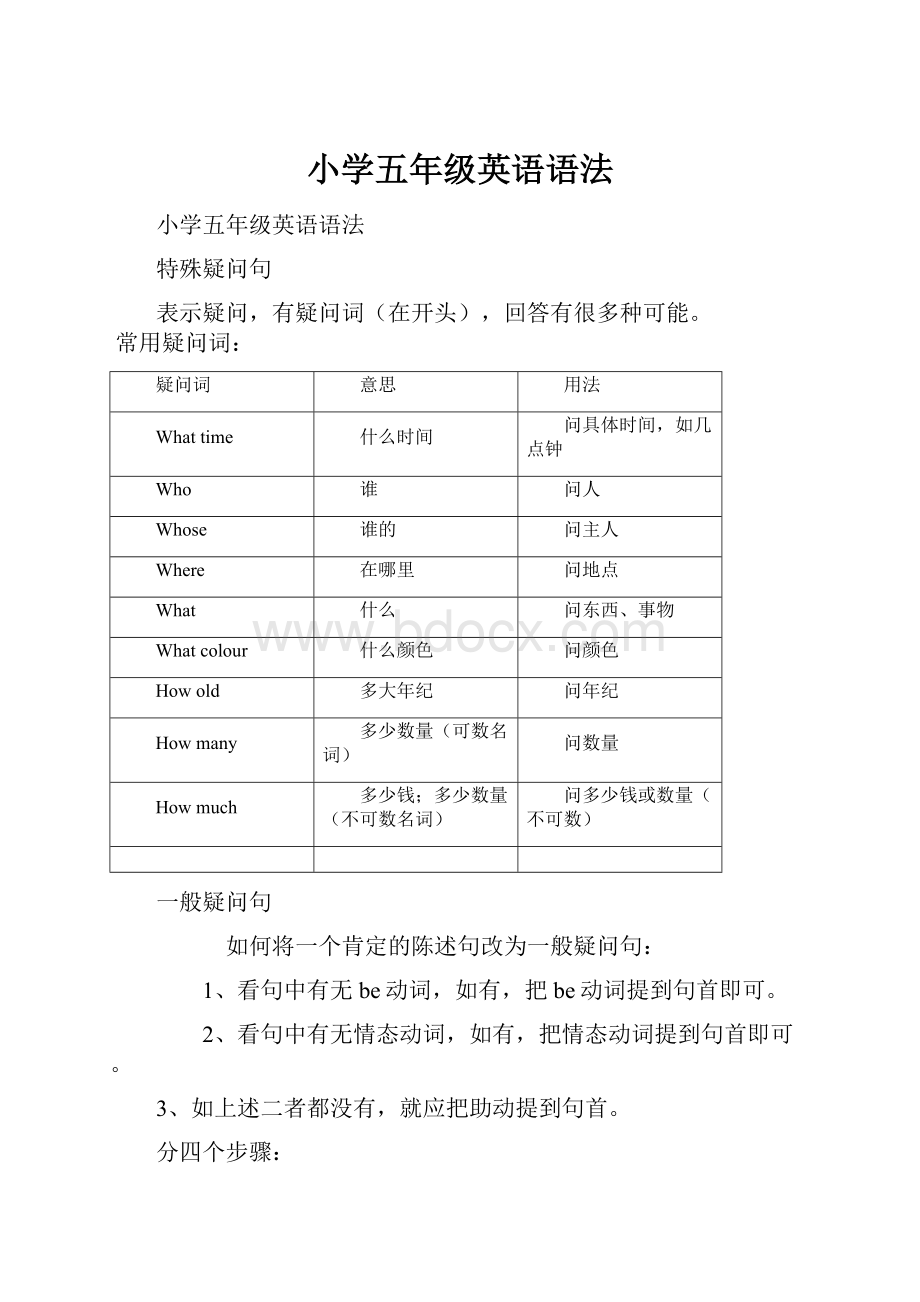小学五年级英语语法.docx
《小学五年级英语语法.docx》由会员分享,可在线阅读,更多相关《小学五年级英语语法.docx(10页珍藏版)》请在冰豆网上搜索。

小学五年级英语语法
小学五年级英语语法
特殊疑问句
表示疑问,有疑问词(在开头),回答有很多种可能。
常用疑问词:
疑问词
意思
用法
Whattime
什么时间
问具体时间,如几点钟
Who
谁
问人
Whose
谁的
问主人
Where
在哪里
问地点
What
什么
问东西、事物
Whatcolour
什么颜色
问颜色
Howold
多大年纪
问年纪
Howmany
多少数量(可数名词)
问数量
Howmuch
多少钱;多少数量(不可数名词)
问多少钱或数量(不可数)
一般疑问句
如何将一个肯定的陈述句改为一般疑问句:
1、看句中有无be动词,如有,把be动词提到句首即可。
2、看句中有无情态动词,如有,把情态动词提到句首即可。
3、如上述二者都没有,就应把助动提到句首。
分四个步骤:
(1)肯定陈述句中本来是没有助动词的,要加上去,位置在主语(某人或某物)后,动词前。
(2)确定助动词用do还是does,根据句中动词,动词是原形的助动词就用do,动词是第三人
称单数的助动词就用does
(3)把助动词后提到句首。
(4)原句中动词假如发生变化就要恢复成原形。
强调一点,有some的要考虑是否要用any。
一般将来时
表示将来将要发生的动作,
经常和tomorrow,nextyear,thedayaftertomorrow,theyearafterthenext,
infivehours'time,etc.表示将来的词联用。
结构:
主语+助动词will+动词原形
IwillgotoAmericatomorrow.
ThepilotwillflytoJapanthemonthafterthenext.
Jackwillmoveintohisnewhousetomorrowmorning.
★变疑问句将助动词移到句首
WillyougotoAmericatomorrow?
WillthepilotflytoJapanthemonthafterthenext?
WillJackmoveintohisnewhousetomorrowmorning?
★变否定句在助动词后面加not
IwillnotgotoAmericatomorrow.
ThepilotwillnotflytoJapanthemonthafterthenext.
Jackwillnotmoveintohisnewhousetomorrowmorning.
★肯定回答及否定回答
Yes,Iwill./No,Iwillnot.
Yes,he/shewill./No,he/shewillnot.
Yes,hewill./No,hewillnot.
★特殊疑问句
Whatwillyoudo?
现在进行时
表示现在正在进行的动作。
构成:
主语+be动词+动词的现在分词+其它成分
Wearehavinglunch.
Heisreadingabook.
Thedogisrunningafteracat.
Theboysareswimmingacrosstheriver.
★变疑问句将be动词移到句首
Arewehavinglunch?
Ishereadingabook?
Isthedogrunningafteracat?
Aretheboysswimmingacrosstheriver?
★变否定句在be动词后面加not
Wearenothavinglunch.
Heisnotreadingabook.
Thedogisnotrunningafteracat.
Theboysareswimmingacrosstheriver.
★特殊疑问句:
what,which,how,where,who,etc.
疑问词+动词+主语+现在分词
Whatareyoudoing?
Whatisshedoing?
Whatisthedogdoing?
没有进行时的动词(必背)
表示状态,思想,感情和感觉的动词不能表示正在进行的动作
1.表示感觉,感官的词
see,hear,like,love,want,
2.have,has当”拥有”讲时没有进行时
过去式
表示过去发生的动作或事件
常和表示过去的时间状语连用,如yesterday,lastnight,thedaybeforeyesterday,3daysago,
含有be动词的句子,将动词变为过去式,am,is的过去式为was,are的过去式为were
Iwasatthebutcher’s.
Youwereastudentayearago.
Theteacherwasverybeautifultenyearsago.
★变疑问句将be动词移动到句首
Wereyouatthebutcher’s?
Wereyouastudentayearago?
Wastheteacherverybeautifultenyearsago?
★变否定句在be动词后面加not
Iwasnotatthebutcher’s.
Youwerenotastudentayearago.
Theteacherwasnotverybeautifultenyearsago.
★肯定回答否定回答
Yes,Iwas.No,Iwasnot.
Yes,youwere.No,youwerenot.
Yes,he/shewas.No,he/shewasnot.
★特殊疑问句:
Whatdidyoudo?
(必背)
不含有be动词的句子,将动词变为过去式
Ifinishedmyhomeworkyesterday.
Theboywenttoarestaurant.
TheSawyerslivedatKingStreetayearago.
★变疑问句在句首加did,动词变为原型
Didyoufinishyourhomeworkyesterday?
Didtheboygotoarestaurant?
DidtheSawyersliveatKingStreetayearago?
★变否定句在主语和动词之间加didnot
Ididnotfinishmyhomeworkyesterday.
Theboydidnotgotoarestaurant.
TheSawyersdidnotliveatKingStreetayearago.
★肯定回答及否定回答
Yes,Idid.No,Ididn’t.
Yes,hedid.No,hedidn’t.
Yes,theydid.No,theydidnot.
现在完成时
构成:
主语+助动词have,has+过去分词
用法:
2)表示过去发生的和现在有某种联系的动作,常和just,usually,already,since等时间副词连用
Ihavejusthadlunch.(饱了,不用再吃了)
Hehashadacupoftea.(不渴了,不用再喝)
Theyhavealreadyhadtheirholiday.(不能再度假了)
Theboyhasalreadyreadthebook.(已经知道书的内容了,不用再看了)
3)询问别人是否做过某事一般用现在完成时:
Haveyoufinishedyourhomework?
HaveyoubeentoBeijing?
Haveheseenthefilm?
4)表示开始于过去并持续到现在的动作
IhavelivedinBeijingfortwentyyears.
Ihaveworkedforthisschoolfor1year.
5)表示一种经历,经验:
去过…地方,做过…事情,经历过…事情
Ihaveneverhadabath.
Ihaveneverseenafilm.
Ihaveneverbeentocinema.
IhaveeverbeentoParis.
Havebeento表示去过,havegoneto表示去了
IhavebeentoLondon.(人已经回来)
HehasgonetoLondon.(人还在那里)
6)表示一种结果,一般不和时间副词联用
Ihavelostmypen.
Ihavehurtmyself.
Hehasbecomeateacher.
Shehasbrokenmyheart.
句型变化:
★变疑问句将助动词移到句首,变否定句在助动词后面加not.
e.g.Haveyoulostyourpen?
Ihavenotlostmypen.
★肯定回答及否定回答
Yes,Ihave.No,Ihavenot.
★特殊疑问句:
Whathaveyoudone?
Whathashedone?
一般过去时与现在完成时的区别:
凡是有明确的表示过去的时间状语的句子为过去时
注意:
有些动词表示的动作有一个终点,不能再延续,因此不能和表示一段时间状语连用
错:
I’veleftBeijingfor3days.
对:
IleftBeijing3daysago.Ihavebeenawayfrombeingfor3days.
过去完成时
用法:
在过去的时间里,两个动作中,发生在前的那个动作要用过去完成时。
结构:
had+过去分词
Aftershehadfinishedherhomework,shewentshopping.
TheyhadsoldthecarbeforeIaskedtheprice.
ThetrainhadleftbeforeIarrivedatthestation.
After/before引导的时间状语从句放在句首要在句子后面加逗号,如果放在主句后则不用加。
1.变疑问句将助动词移到句首
Hadshefinishedherhomework?
2.变否定句在助动词后面加not
Shehadn’tfinishedherhomework.
3.肯定回答及否定回答
Yes,shehad.No,shehadn’t.
4.特殊疑问句:
Whathadshedone?
名词
这里强调两点:
不可数名词都默认为单数,所以总是用is
名词复数如何加后缀:
各种不同情况
变化方法
例词
一般情况
直接加-s
book-booksbag-bagscat-catsbed-beds
以s.x.sh.ch结尾
加-es
bus-busesbox-boxesbrush-brushes
watch-watchespeach—peachesglass--glasses
以“辅音字母+y”结尾
变y为i,再加-es
family-familiesstudy--studies
以“f或fe”结尾
变f或fe为v,再加-es
knife-knives
不规则名词复数
man-menwoman-womenpoliceman-policemenpolicewoman-policewomenmouse-micefoot-feetchild-childrenfish-fishChinese-Chinese
人称代词和物主代词
人称代词
物主代词
单数
复数
单数
复数
主格
宾格
主格
宾格
形容词性
形容词性
第一人称
I(我)
me
we(我们)
us
my(我的)
our(我们的)
第二人称
you(你)
you
you(你们)
you
your(你的)
your(你们的)
第三人称
he(他)
him
they
(他/她/它们)
them
his(他的)
their
(他/她/它们的)
she(她)
her
her(她的)
it(它)
it
it(它的)
小学五年级英语重点语法归纳
1:
"first"是序数词,与"the"相连,解释为第一。
2:
像"first,term,world"作为词组出现时前面要加"the"。
3:
"all"所有;后面的可数名词用复数形式,be动词用"are"。
4:
"any"一些;用在否定句和一般疑问句中,与"some"同义。
"some"用在肯定句中。
5:
therebe+数词,采用"就近原则"。
6:
amapofChina与amapoftheworld要牢记。
7:
要用"onthewall",不能用"inthewall"。
门、窗在墙上才能用"inthewall"。
8:
can后+动词原形。
9:
play+the+乐器;play+球类;
10:
like的用法+可数名词复数形式(指一类的东西)。
+this+名词单数。
+some+不可数名词。
+动词ing形式(动名词)。
11:
动词变动名词形式方法:
A--直接在动词后面+ing形式(大多数)。
B--以不发音的"e"结尾的,要去掉e后再+ing,比如:
dancing,making,riding。
C--重读be音节,末尾只有一个辅音,须双写末尾的字母后再+ing
如:
running,swimming,sitting,putting。
12:
现在进行时的构成:
be动词+动词ing形式。
标志:
now、look、listen、it'stimeto。
13:
现在进行时的一般疑问句/问--be动词+人称+时态(动词ing)
答--Yes,he/She/itis/am/are.No,he/She/itisn't/aren't/amnot.
14:
用Areyou...?
Yes,Iam/weare.No,I'mnot/Wearen't.
15:
动词后+人称宾格形式.
16:
一般现在时的构成:
第三人称单数(三单)。
要注意:
后面的动词+s或es。
特例:
have→hasdo→dosego→goes;标志:
often,usually。
17:
有些名词变动词时要变形式,例如:
teacher→teach;driver→drive.